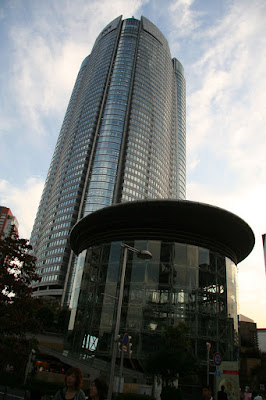Roppongi Hills and Mori Tower Megaplex
Roppongi Hills is a megaplex of underground and above ground construction that I had always wanted to see. It didn't disappoint. Another Tokyo megaplex is the Shiodome which I posted about here and that was pretty cool too. A large underground mall complex with a huge glass enclosed atrium is also located here. You can access the Roppongi Hills complex via the subway with a golden themed subway station that looks very posh. Tokyo Midtown is also nearby, so you might also want to visit it too. I posted a travelogue article with Roppongi in it here previously.
This was the largest urban redevelopment project done in Japan. Constructed by building tycoon Minoru Mori, the mega-complex incorporates office space, apartments, shops, restaurants, cafés, movie theaters, a museum, a hotel, a major TV studio, an outdoor amphitheater, and a few parks. The centerpiece is the 54-story Mori Tower. Mori's stated vision was to build an integrated development where high-rise inner-urban communities allow people to live, work, play, and shop in proximity to eliminate commuting time. He argued that this would increase leisure time, quality of life, and benefit Japan's national competitiveness. From Wikipedia.
The Mori Tower is a 54-story mixed-use skyscraper completed in 2003 that is named after builder Minoru Mori and is the centerpiece of the Roppongi Hills. It is currently the fifth-tallest building in Tokyo at 238 meters (781 ft). The building is primarily used for office space, but it also includes retail stores, restaurants and other tourist attractions. The Mori Art Museum is located on the 53rd floor and visitors can view the city from observation decks on the 52nd and 54th floors. The headquarters of Mori Building Company are located in this building. Visitors are provided with views of the city at Tokyo City View on the 52nd floor and an open-air roof deck on the 54th floor. From Wikipedia
Before I made it to Tokyo for the first time I had seen these wonderful night pictures of the Mori Tower with the Spider at the base. The tower itself changes colour at night like many of the buildings in Hong Kong and it is very pretty. Combined with the scary spider statue it looked like something I wanted to see in person. The spider is one of many famous spider sculptures "Maman" by Louise Bourgeois. These spider statues are strategically taking over the world as they are in numerous cities!
The Mori Tower is the heart of the complex and it contains a mall with lofty ceilings, theaters, the Mori Art Museum, a fantastic modern art museum, on the Tokyo City View observation deck floor. The observation deck here on the 52 floor was higher than the Tokyo Tower observation deck and provided very good views of the city. I loved it. In fact, there is also a rooftop observation deck that would probably be
pretty cool to view the city from at night with a light breeze in the
air.
However, next time I'm in Tokyo it will be a priority for me to check out the Tokyo Skytree first, but I'll definitely make it a priority to visit here again if there is a great art exhibit at the Mori Art Museum. In the Roppongi Hills complex are the Grand Hyatt Hotel of "Lost In Translation" fame, a neat park with some fascinating modern sculpture, and a playground with Robot Totem Poles. On a side note, the whole Roppongi area gets blasted into rubble in the anime Birdy the Mighty: Decode by an energy weapon strike from space. I think the area is better as non-rubble!
Official Roppongi Hills Site: http://www.roppongihills.com/en/
Official Mori Art Museum Site: http://www.mori.art.museum/html/eng/index.html
Tokyo City View Observation Deck Site: http://www.roppongihills.com/tcv/en/
 |
| Mori Tower and Mall Entrance |
This was the largest urban redevelopment project done in Japan. Constructed by building tycoon Minoru Mori, the mega-complex incorporates office space, apartments, shops, restaurants, cafés, movie theaters, a museum, a hotel, a major TV studio, an outdoor amphitheater, and a few parks. The centerpiece is the 54-story Mori Tower. Mori's stated vision was to build an integrated development where high-rise inner-urban communities allow people to live, work, play, and shop in proximity to eliminate commuting time. He argued that this would increase leisure time, quality of life, and benefit Japan's national competitiveness. From Wikipedia.
The Mori Tower is a 54-story mixed-use skyscraper completed in 2003 that is named after builder Minoru Mori and is the centerpiece of the Roppongi Hills. It is currently the fifth-tallest building in Tokyo at 238 meters (781 ft). The building is primarily used for office space, but it also includes retail stores, restaurants and other tourist attractions. The Mori Art Museum is located on the 53rd floor and visitors can view the city from observation decks on the 52nd and 54th floors. The headquarters of Mori Building Company are located in this building. Visitors are provided with views of the city at Tokyo City View on the 52nd floor and an open-air roof deck on the 54th floor. From Wikipedia
View Shibuya Shinjuku Harajuku in a larger map
Before I made it to Tokyo for the first time I had seen these wonderful night pictures of the Mori Tower with the Spider at the base. The tower itself changes colour at night like many of the buildings in Hong Kong and it is very pretty. Combined with the scary spider statue it looked like something I wanted to see in person. The spider is one of many famous spider sculptures "Maman" by Louise Bourgeois. These spider statues are strategically taking over the world as they are in numerous cities!
 |
| Maman (the spider) and Mori Tower |
 |
| City View Observation Deck |
Official Roppongi Hills Site: http://www.roppongihills.com/en/
Official Mori Art Museum Site: http://www.mori.art.museum/html/eng/index.html
Tokyo City View Observation Deck Site: http://www.roppongihills.com/tcv/en/












Comments
Post a Comment